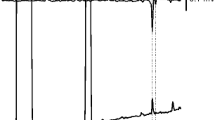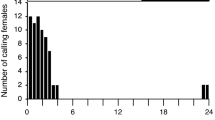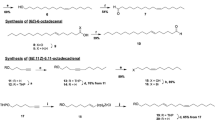Abstract
Sex pheromones of nocturnal hawk moths have been identified previously, but not those of diurnal hawk moths. Here, we report laboratory analyses and field testing of the sex pheromone of the diurnal hawk moth, Hemaris affinis (Bremer 1861) (Lepidoptera: Sphingidae). Sex pheromone glands were removed and extracted in hexane during peak calling activity of virgin female moths. Analysis of gland extracts by gas chromatography (GC) with electroantennographic detection revealed three components that elicited responses from male moth antennae. These components were identified, based on their mass spectra and retention indices on two GC columns, as (Z)-11-hexadecenal and (10E, 12Z)- and (10E,12E)-10,12-hexadecadienals with a ratio of 45:20:35. In a field experiment, traps baited with the three-component synthetic blend, but none of the single- or two-component blends, caught male moths. All three pheromone components have been identified previously in pheromones of other Lepidoptera, including Sphingid moths, and thus the ternary blend is probably responsible for the species specificity of the pheromone of this moth.

Similar content being viewed by others
References
Ando T, Yamakawa R (2011) Analyses of lepidopteran sex pheromones by mass spectrometry. Trends Anal Chem 30:990–1002
Ando T, Ogura Y, Uchiyama M (1988) Mass spectra of lepidopterous sex pheromones with a conjugated diene system. Agric Biol Chem 52:1415–1423
Anonymous (2006) Major insect and other pests of economic plants in Japan. The Japanese Society of Applied Entomology and Zoology, Tokyo, p 387, in Japanese
Balkenius A, Kelber A (2006) Colour preferences influences odour learning in the hawkmoth, Macroglossum stellatarum. Naturwissenschaften 93:255–258
Balkenius A, Rosen W, Kelber A (2006) The relative importance of olfaction and vision in a diurnal and a nocturnal howkmoth. J Comp Physiol A 192:431–437
Bestmann HJ, Erler J, Garbe W, Kern F, Martischonok V, Schäfer D, Vostrowsky O, Wasserthal LT (1992) Pheromone components of the female elephant hawk-moth, Deilephila elpenor, and the silver-striped hawk-moth, Hippotion celerio. Experientia 48:610–613
El-Sayed AM (2014) The pherobase. http://www.pherobase.com/
Hidaka T (1972) Biology of Hyphantria cunea drury (Lepidoptera: Arctiidae) in Japan. XIV mating behavior. Appl Entomol Zool 7:116–132
Hothorn T, Bretz F, Westfall P (2008) Simultaneous inference in general parametric models. Biom J 50:346–363
Judd GJ, Eby C (2014) Spectral discrimination by Synanthedon myopaeformis (Lepidoptera: Sesiidae) when orienting to traps baited with sex pheromone or feeding attractants. Can Entomol 146:8–25
Kawahara AY, Mignault AA, Regier JC, Kitching IJ, Mitter C (2009) Phylogeny and biogeography of hawkmoths (Lepidoptera: Sphingidae): evidence from five nuclear genes. PLoS One 4:e5719
Kennedy JS (1977) Olfactory responses to distant plants and other odor sources. In: Shorey HH, Mckelvey JJ Jr (eds) Chemical control of insect behavior. Wiley, NY, pp 67–91
Kindl J, Kalinová B, Červenka M, Jílek M, Valterová I (2011) Male moth songs tempt females to accept mating: The role of acoustic and pheromonal communication in the reproductive behaviour of Aphomia sociella. PLoS One 6:e26476
KonDo Y, Naka H, Tsuchida K (2012) Pheromones and body coloration affect mate recognition in the Japanese nine-spotted moth Amata fortunei (Lepidoptera: Arctiidae). J Ethol 30:301–308
Kováts E (1958) Gas-chromatographische charakterisierung organischer verbindungen. teil 1: retentionsindices aliphatischer halogenide, alkohole, aldehyde und ketone. Helv Chim Acta 41:1915–1932
Landolt PJ, Tumlinson JH, Brennan MM (1989) Attraction of Amphion floridensis (Lepidoptera: Sphingidae) to bombykal, (E, Z)-10,12-hexadecadienal. Fla Entomol 72:324–327
Marques FA, McElfresh JS, Millar JG (2000) Kováts retention indexes of monounsaturated C12, C14, and C16 alcohols, acetates and aldehydes commonly found in lepidopteran pheromone blends. J Braz Chem Soc 11:592–599
Nakano R, Takanashi T, Skals N, Surlykke A, Ishikawa Y (2010) Ultrasonic courtship songs of male Asian corn borer moths assist copulation attempts by making the females motionless. Physiol Entomol 35:76–81
Nieukerken EJ et al (2011) Order Lepidoptera Linnaeus, 1758. In: Zhang, Z.-Q. (Ed.) Animal biodiversity: An outline of higher-level classification and survey of taxonomic richness. Zootaxa 3148: 212–221
Pittaway AR (1993) The hawkmoths of the western Palaearctic. Harley books, Colchester, pp 156–157
R core team (2013) R: A language and environment for statistical computing. R Foundation for Statistical Computing, Vienna, URL http://www.R-project.org/
Raguso RA, Willis MA (2002) Synergy between visual and olfactory cues in nectar feeding by naı̈ve hawkmoths, Manduca sexta. Anim Behav 64:685–695
Raguso RA, Willis MA (2005) Synergy between visual and olfactory cues in nectar feeding by wild hawkmoths, Manduca sexta. Anim Behav 69:407–418
Reed DW, Underhill EW, Giblin EM (1987) Attraction of sphingid moths (Lepidoptera: Sphingidae) to 10,12-hexadecadienyl aldehydes and acetates: evidence of pheromone components. J Chem Ecol 13:931–942
Tamaki Y (1977) Complexity, diversity, and specificity of behavior- modifying chemicals in Lepidoptera and Diptera. In: Shorey HH, Mckelvey JJ Jr (eds) Chemical control of insect behavior. Wiley, NY, pp 253–285
Tumlinson JH, Mitchell ER, Doolittle RE, Jackson DM (1994) Field tests of synthetic Manduca sexta sex pheromone. J Chem Ecol 20:579–591
Uehara T, Naka H, Matsuyama S, Ando T, Honda H (2012) Identification and field evaluation of sex pheromones in two hawk moths Deilephila elpenor lewisii and Theretra oldenlandiae (Lepidoptera; Sphingidae). Appl Entomol Zool 47:227–232
Uehara T, Naka H, Matsuyama S, Vang LV, Ando T, Honda H (2013) Identification of conjugated pentadecadienals as sex pheromone components of the sphingid moth, Dolbina tancrei. J Chem Ecol 39:1441–1447
van Dool HD, Kratz PD (1963) A generalization of the retention index system including linear temperature programmed gas—liquid partition chromatography. J Chromatogr 11:463–471
Wakamura S, Yasuda T, Watanabe M, Kiguchi K, Shimoda M, Ando T (1996) Sex pheromone of the sweetpotato hornworm, Agrius convolvuli (L.) (Lepidoptera: Sphingidae): identification of a major component and its activity in a wind tunnel. Appl Entomol Zool 31:171–174
Witzgall P, Trematerra P, Liblikas I, Bengtsson M, Unelius CR (2010) Pheromone communication channels in tortricid moths: lower specificity of alcohol vs. acetate geometric isomer blends. Bull Entomol Res 100:225–230
Acknowledgments
We thank Dr. DeMar Taylor for critical reading of the manuscript and Mr. Takahiro Yano for providing important information. We also are grateful to the members of the Laboratory of Applied Entomology in Tottori University, especially Ms. Kanako Ohbayashi and Mr. Seto Yasufuku for help with field bioassays and insect rearing. This work was supported by a Grant-in-Aid for JSPS Fellows.
Author information
Authors and Affiliations
Corresponding author
Rights and permissions
About this article
Cite this article
Uehara, T., Naka, H., Matsuyama, S. et al. Identification of the Sex Pheromone of the Diurnal Hawk Moth, Hemaris affinis . J Chem Ecol 41, 9–14 (2015). https://doi.org/10.1007/s10886-014-0537-7
Received:
Revised:
Accepted:
Published:
Issue Date:
DOI: https://doi.org/10.1007/s10886-014-0537-7




